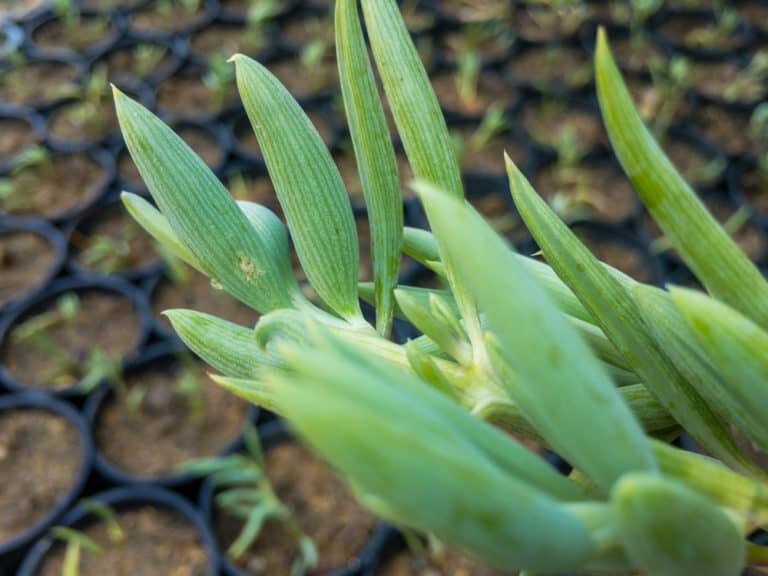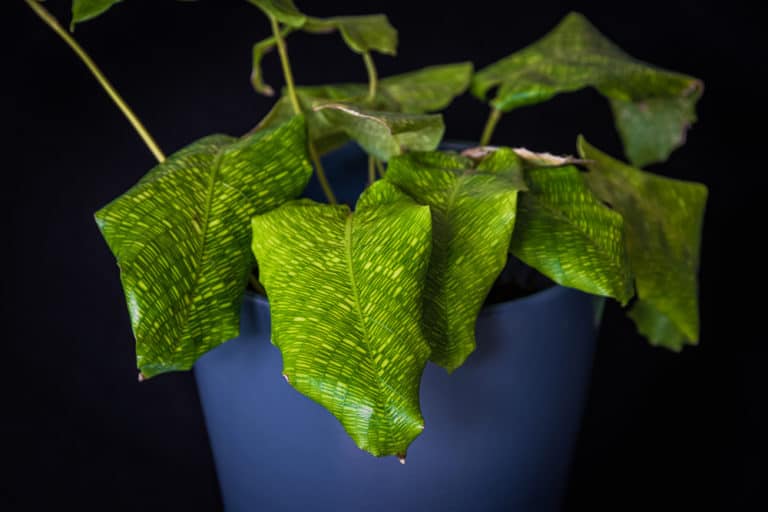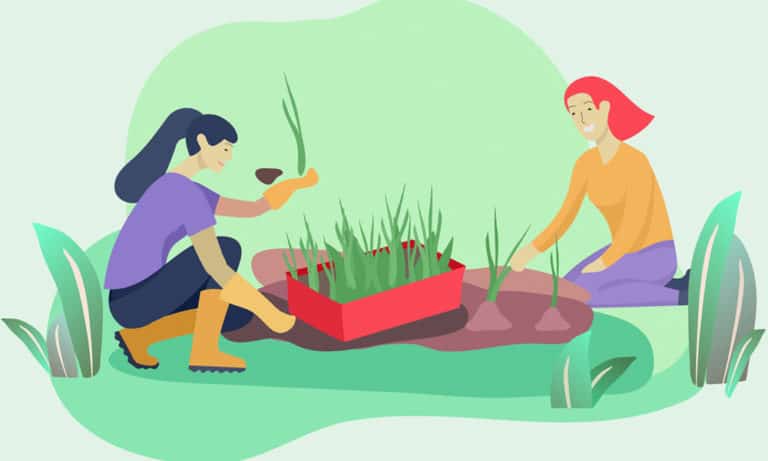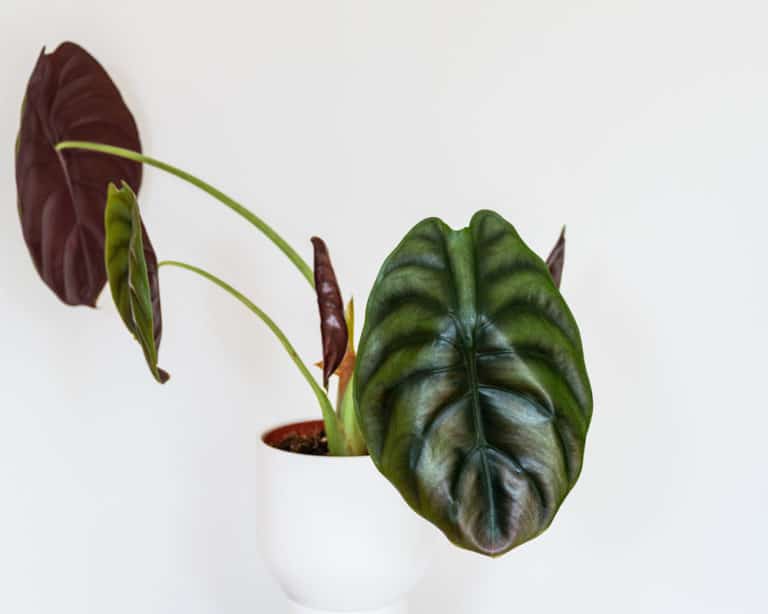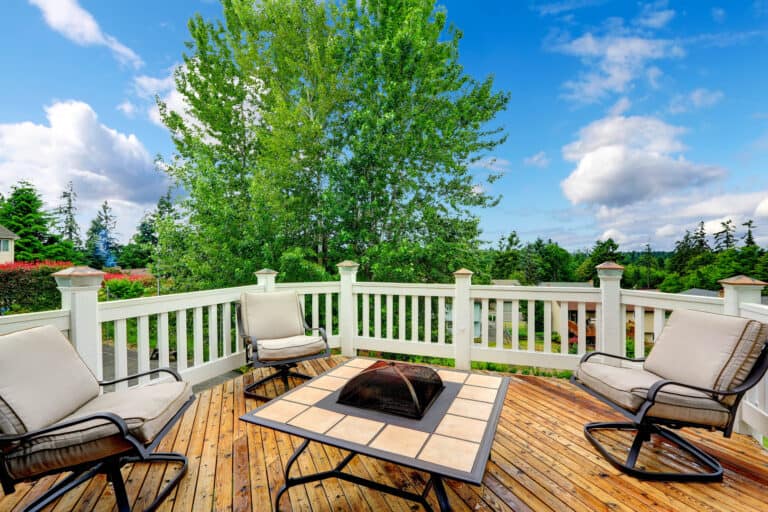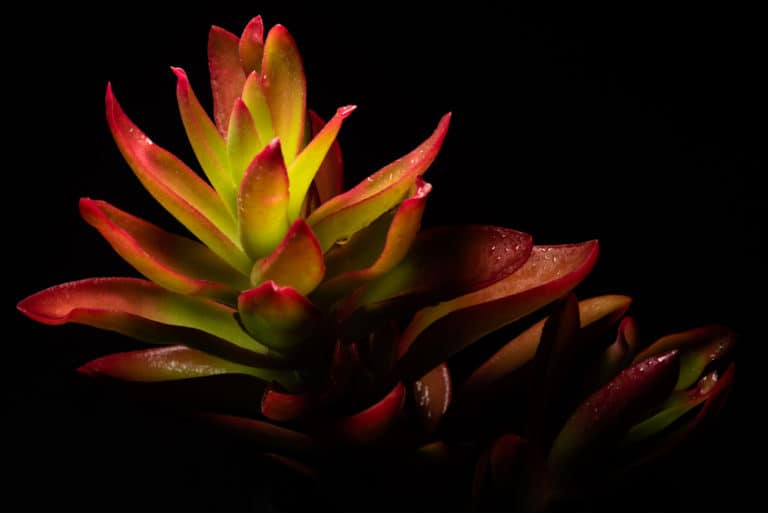Alocasia Amazonica ‘Polly’ Care Guide (2024)
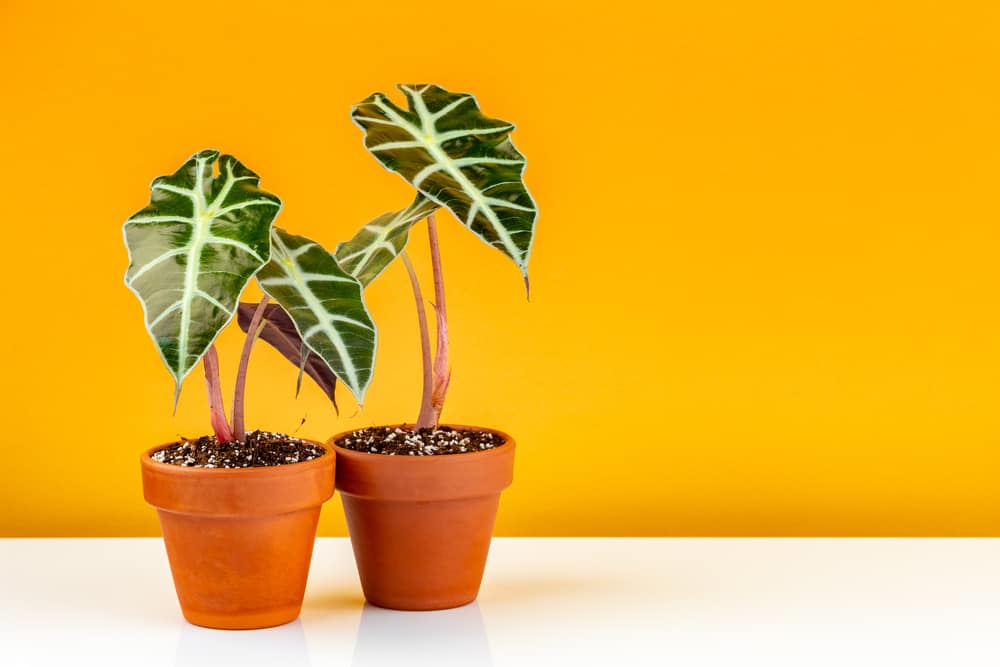
Alocasia Polly is a striking foliage plant that was developed as a smaller cultivar of Alocasia amazonica. Its compact size makes it an ideal houseplant.
The large, boldly patterned leaves will make it a standout in an indoor garden, bringing a feel of the tropics to your home or office.
| Scientific Name | Alocasia × amazonica ‘Polly’ |
| Common Name | Alocasia Polly, Amazonian Elephant’s Ear, African Mask Plant |
| Light | Bright indirect sunlight |
| Watering | Water if the top inch of soil is dry |
| Temperature | 64 to 77ºF (18 to 25ºC) |
| Hardiness Zone | 10 to 12 |
| Humidity | 60 to 75% |
| Soil Type | Rich, quick-draining, loamy |
| Soil pH | 5.5 to 6.5 (mildly acidic) |
| Fertilizing | A balanced feed once a month in spring and summer |
| Repotting | Every 2 to 3 years |
| Pruning | Only for removal of damaged leaves |
| Propagation | Division |
| Toxicity | Toxic to humans and pets |
| Mature Size | 12 to 24 inches as a houseplant |
| Bloom Time | Rarely blooms indoors |
What’s Unique About Alocasia Polly?
Ironically, although two of the common names for the Alocasia Polly plant are Amazonian Elephant’s Ear and African Mask Plant, its roots are in another continent altogether.
The parents of Alocasia Polly plants are native to China, Southeast Asia, and the Philippines, and this cultivar was developed by a Florida breeder in the 1950s.
The large leaves with their unique pattern are the main attraction of this tropical houseplant.
At the same time, its small size means that even in homes with limited space, you can find room for growing Alocasia Polly.
It can also help clear your air of harmful chemicals such as formaldehyde.
Alocasia Polly Care
Alocasia Polly’s family of plants originates in the rainforests of Southeast Asia.
Because of this, good Alocasia Polly plant care entails supplying this tropical plant with growing conditions as close to the rainforest as is practical.
Alocasia amazonica care essentially involves bright, indirect light, consistently moist soil, and a warm, humid environment.
Light
In the rainforest, Alocasias grow on the forest floor under the tree canopy. While the tropical sun is hot and bright, the trees filter it for the understory plants.
In your home, Alocasia Polly light requirements are for bright but indirect light, or between 10,000 to 20,000 lux.
Alocasia amazonica light needs can be met by placing it directly in an east or north window where it will receive the less intense morning light.
If all you have is a south or west exposure, find a spot in the room out of the full sun, which can burn the leaves or bleach out their color.
Watering
In the rainforest, Alocasias thrive in damp soil which is never saturated. Your Alocasia Polly watering routine needs to maintain the same consistent moistness.
Water Alocasia amazonica whenever the top inch of the soil is dry. This will be at least once a week during the growing season. Just gently moisten the top layer.
Never let your Alocasia Polly sit in water. The roots need air, and saturated soil will not let it get to them.
Alocasia Polly watering needs are less in its winter dormant phase. You can let the soil dry out to about halfway down before watering.
Temperature
The best Alocasia Polly temperature range is 64 to 77ºF (18 to 25ºC).
Luckily, most modern heated homes are kept at an appropriate temperature for Alocasia amazonica.
Alocasia Polly has limited temperature tolerance below that range. If temperatures fall below 64ºF (18ºC), it will go into dormancy and growth will stop.
Even being in a draft or too close to an air conditioning vent can have an adverse effect on your Alocasia Polly. Also, keep it away from windows when it’s really cold outside.
Finally, Alocasia Polly has no frost hardiness. Even a brief exposure to 32ºF (0ºC) can cause irreparable damage.
Humidity
Alocasia Polly humidity requirements are high, because that is what it’s like in the rainforests where Alocasias grow wild.
The ideal humidity for Alocasia amazonica is between 60 and 75%. That humidity level is of course not advisable for your home, but there are ways to create a humid microclimate for your Alocasia Polly.
Probably the best way to raise the humidity in the air surrounding your Alocasia Polly is to use a small humidifier.
Grouping all of your tropical plants together will allow all of them to benefit at once from the extra moisture.
You could also regularly mist your Alocasia Polly’s leaves, or place its pot atop a pebble tray filled with water.
Soil
Alocasia Polly soil has to both hold enough water to stay consistently moist, while at the same time drain excess water and let the roots breathe.
The pH level for Alocasia amazonica is 5.5 to 6.5, or mildly acidic.
You can buy a commercial aroid mix to use as the soil for Alocasia amazonica. African violet soil will also meet all of Alocasia Polly’s needs.
However, you can also make your own soil mix.
Standard indoor potting soil can be mixed with equal parts of perlite and peat moss for a well-draining soil that will retain sufficient moisture.
Fertilizer
You should use a fertilizer for Alocasia amazonica to encourage strong, healthy growth of its large leaves.
Alocasia Polly fertilizer should have a fertilizer ratio of 10-10-10.
Liquid houseplant fertilizers are the easiest way to feed your Alocasia Polly. Dilute it to half the recommended strength to avoid burning the roots.
Apply the liquid fertilizer evenly around the soil surface. You should do this right after you’ve watered the plant to ensure that the liquid is absorbed into the moist soil.
You should feed your Alocasia Polly once a month during spring and summer, but not during its dormant period in the fall and winter.
Potting & Repotting
While Alocasia Polly does not mind being a little root-bound, Alocasia Polly repotting should be done every 2 or 3 years.
Repotting Alocasia amazonica gives you an opportunity to divide the roots to propagate more plants.
You should also refresh the potting soil at the same time.
Only move up one pot size, or at most 2 inches across, when selecting a new pot for your Alocasia Polly.
It’s a good idea to use a glazed clay or plastic pot, as a pot with porous materials will lead to the soil drying out too quickly. Just make sure it’s got good drainage holes.
Pruning
Alocasia Polly pruning is rarely necessary.
You cannot limit the height of your Alocasia Polly by pruning at the top, as new leaves are borne on stems that grow from the base.
It’s not advisable to remove healthy stems and leaves.
The only time you should be cutting Alocasia amazonica is to remove dead or damaged leaves.
Not only will these leaves mar the appearance of your Alocasia Polly, but they can also harbor pests and disease.
Don’t just cut off the leaf; take out the entire stem down to the soil level.
To trim your Alocasia Polly, always use sharp, sterilized knives or scissors.
Propagation
Alocasia Polly propagation is usually done by root division. Stem cuttings will not produce new plants.
However, it’s really very easy to propagate Alocasia amazonica when you are repotting your plant every 2 years or so.
Start by pulling the root ball out of the pot, and shake off as much of the soil as you can.
You should see a tangle of individual corms twisted together. Gently tug them apart, cutting only when necessary.
Each plantlet that has both roots and leaves can be potted up separately, either to expand your own tropical garden or to share with others.
Also, make sure to check out our in-depth Alocasia silver dragon plant care guide.
Common Problems of Alocasia Polly
Alocasia Polly can be a little fussy to grow, but most Alocasia Polly problems can be avoided by providing it with the proper growing conditions.
If problems with Alocasia amazonica do develop, most of them can easily be resolved.
The leaves of your Alocasia Polly act as a good early warning system for any potential issues.
Pests
There are very few Alocasia Polly pests. In fact, the only bugs that you are likely to find on your Alocasia amazonica are spider mites.
Spider mites suck the sap out of the leaves of Alocasia Polly, leaving a series of small white or yellow dots that will eventually turn brown.
It’s hard to actually detect spider mites, as they are very small, but you may also find their sticky webs in more advanced infestations.
Take your Alocasia Polly into the shower and spray down all surfaces. This should remove the bugs.
Keep them away for good by wiping down the leaves once a month with a neem oil solution.
Diseases
Most Alocasia Polly diseases are encouraged by the moist soil and high humidity that this plant needs to thrive.
Since you can’t keep Alocasia amazonica without the moisture, you need to keep an eye out for any signs of disease.
Root rot is the most common disease affecting Alocasia Polly. If the leaves start drooping and turning yellow, and the stems become soft, pull the root ball out of its pot.
Cut away any roots that are turning black, as well as the affected leaves and stems. Repot in fresh soil.
Rust is a fungal disease that causes orange to brown spots on the leaves. It’s caused by wet conditions on the foliage. Cut out all affected leaves, and do not mist the leaves in future.
Growing Problems
Other growing problems aren’t caused by pests or disease, but rather by poor growing conditions resulting in a sick plant.
Just giving it a more nurturing environment can restore it to health.
If the edges of your Alocasia Polly’s leaves are turning brown and crisp, and the plant is drooping, it needs more water. Increase your watering frequency.
If the leaves are curling up, it needs higher humidity and/or less bright light.
If your Alocasia Polly’s leaves are dying off, there’s a good chance that it’s not in a warm enough spot and is going dormant. Move it to a warmer spot out of drafts.
Toxicity of Alocasia Polly
Alocasia amazonica is toxic to humans and animals, so care should be taken when growing this tropical plant.
Its toxicity is caused by calcium oxalate, which is found in all parts of the plant.
Calcium oxalate has tiny sharp crystals that can pierce sensitive tissues and cause potentially life-threatening reactions, especially in children and pets.
For Humans
Alocasia Polly is toxic to humans.
While adults are unlikely to try eating this ornamental plant, young children may get curious and try a bite.
If they just ingest a bit, the most likely reaction is some localized pain in their lips and mouth. Clean away the plant material and give them a popsicle to soothe the pain.
However, if they have a swollen tongue, or difficulty breathing, take them to the emergency room immediately.
If you have sensitive skin, you may develop a rash if exposed to the sap. Rinse it off and use an antihistamine cream to soothe symptoms.
For Pets
Pets can have a severe and possibly life-threatening reaction to ingesting Alocasia Polly foliage or stems.
If your cat, dog, or rabbit starts drooling excessively, vomiting, or wheezing, or has diarrhea, you should take it to the veterinarian immediately.
It’s a good idea to prevent a situation like this from arising by finding a spot for your Alocasia Polly that pets and children can’t reach.
Since a mature Alocasia Polly may only grow to 2 feet tall, it can easily be kept on a shelf several feet above floor level.
If you keep it in your bathroom because of the higher humidity levels, keeping the door closed will solve the problem, too.
Alocasia Polly Appearance
Between its striking, large leaves and elegant growth habit, the Alocasia Polly appearance will stand out wherever it is used.
Whether it’s a solitary specimen plant, or included in a larger indoor garden, its evergreen good looks will always get a reaction.
While it may never flower for you, the leaves alone are enough to make it worth growing.
Foliage
The foliage of Alocasia Polly is its most outstanding characteristic.
An Alocasia Polly leaf can grow up to a foot long, and is shaped like an arrowhead. The edges are ruffled, and the whole leaf has a rippled appearance.
The dark green, glossy leaves have thick contrasting veins in shades of silvery white. They have a leathery texture.
Alocasia Polly is evergreen, so while some older leaves may die off during its winter dormancy, most foliage remains intact.
Because the leaves last a long time, they should be wiped down once a month to remove any dust that has accumulated.
Flowering
It is very unlikely that you will see an Alocasia Polly flowering when it is grown indoors in a pot.
Blooming usually only occurs on Alocasia Polly plants grown outdoors in a tropical zone. The bloom time is in summer.
The flowers are small and insignificant, with a green spathe wrapped around a white spadix.
Many growers choose to cut out flower stalks before they bloom. Flowering and setting seeds uses energy that the Alocasia Polly plant could otherwise direct towards its big, beautiful leaves.
For the most part, trying to get your Alocasia Polly to bloom is not worth the effort.
Size and Growth
Alocasia Polly was bred to be a compact version of Alocasia × amazonica, so the size of Alocasia Polly will stay on the small side.
It will grow to a full height and spread of 12 to 24 inches. It has a fast growth rate, producing 1 or 2 new leaves each month during spring and summer.
An Alocasia Polly plant has an average lifespan of about 5 years. However, since it can be propagated by divisions you can always have fresh young plants growing.
Alocasia Polly naturally forms a graceful shape, with leaves arching out on its stiff, upright stems.
Alocasia Polly Fragrance
There is no Alocasia Polly fragrance.
The rare Alocasia amazonica flower has no scent, and the foliage is also unscented.
This can be an advantage if you are growing Alocasia Polly in a small space like a studio apartment and are sensitive to fragrances.
As well, in many public settings such as nursing homes, medical offices, and schools, fragrant plants are not permitted because of some people’s sensitivity. Alocasia Polly is an ideal plant to use in those places.
If you do enjoy scented plants, you can include some such as camellias in your indoor garden to perfume the air while also enjoying the look of Alocasia Polly.
Suggested Uses for Alocasia Polly
If you live in a tropical region, you can grow Alocasia Polly outdoors year-round. Plant it in rich, moist soil in a shady spot, and you may even see flowers develop.
Indoors, the compact size of Alocasia Polly lends itself to a variety of uses. It’s small enough to tuck into a corner of a kitchen counter or on a shelf in a bathroom.
In your bedroom, you can appreciate its beauty by day, and sleep in a less contaminated atmosphere by night as it filters the air.
Even in temperate zones, Alocasia Polly can become a part of your outdoors garden in hot summer months.
FAQ
What is Alocasia Polly?
Alocasia Polly is a hybrid cultivar whose parent plants are native to Southeast Asia. It is evergreen tropical that is grown as an indoor plant.
How to identify Alocasia Polly?
Alocasia Polly has 12-inch long arrowhead-shaped leaves with scalloped edges and a ruffled texture. They are glossy and green, with prominent veins in contrasting white and silver.
How to care for Alocasia Polly?
Alocasia Polly needs to be grown in consistently moist soil, in a warm humid environment and kept out of the direct sun. Water regularly and fertilize monthly.
How to grow Alocasia Polly indoors?
Alocasia Polly can be grown indoors in a location out of the full sun in a warm environment with high humidity. Its soil should always be moist.
How to grow Alocasia Polly outdoors?
Alocasia Polly can be planted in the ground year-round in tropical climates or moved out in pots to a shady location in hot summer weather in temperate zones.
How fast does Alocasia Polly grow?
Alocasia Polly has a fast growth rate and will reach its full size within a couple of growing seasons. However, it is relatively short-lived with a 5-year lifespan.
How tall does Alocasia Polly grow?
Alocasia Polly’s full size is 12 to 24 inches tall and with a similar width. It was bred to be a smaller version of Alocasia × amazonica.
How to make Alocasia Polly grow faster?
Alocasia Polly will grow fastest when grown in ideal conditions of bright, indirect light, warm or even hot temperatures, humidity above 60%, and consistently moist soil.
How to stake Alocasia Polly?
Alocasia Polly naturally grows upright with stiff, erect stems, so staking is not necessary. You should, however, rotate its pot weekly so it does not lean towards the light.
How to pot Alocasia Polly?
Alocasia Polly should be potted in a plastic or glazed clay pot to prevent moisture loss. Use a potting soil that will retain moisture while still letting the roots breathe.
How to revive Alocasia Polly?
If your Alocasia Polly has been growing in cool conditions and lost its leaves, it is dormant. If the corm is healthy, move the pot to a warm spot and let it regrow.
Why is my Alocasia Polly dying?
Your Alocasia Polly may have a fungal disease by being in too damp an environment. Repot it in fresh soil and be careful not to overwater it.
Why is my Alocasia Polly drooping?
Your Alocasia Polly may be drooping because it needs water. If it has dried out too much, put the whole pot in water and let it become fully hydrated.
How cold can Alocasia Polly tolerate?
Alocasia Polly’s growth will slow down or stop completely in temperatures below 64ºF (18ºC), and even a brief exposure to freezing temperatures can kill it.
How to get rid of pests on Alocasia Polly?
Alocasia Polly pests can be controlled by wiping down the leaves regularly with neem oil in water. If spider mites get established, use a hand-held shower head to rinse them off.
Is Alocasia Polly toxic to cats?
Yes, Alocasia Polly is toxic to cats. If your cat starts vomiting or has diarrhea, take it to the veterinarian immediately, as this can be life-threatening.
Is Alocasia Polly toxic to dogs?
Yes, Alocasia Polly is toxic to dogs. If your dog starts wheezing, vomiting, or drooling excessively, take it in to the veterinarian for emergency care.
Is Alocasia Polly toxic to children?
Yes, Alocasia Polly is toxic to children. If your child develops a swollen tongue or has difficulty breathing, you should take them to the emergency room.
Is Alocasia Polly toxic to humans?
Yes, Alocasia Polly is toxic to humans. Exposure to the sap can cause a rash in people with sensitivities. Rinse your exposed skin with soap and water.
Does Alocasia Polly have a scent?
Alocasia Polly has no scent. The rare flowers have no fragrance, and the foliage is scentless, making it a good choice for people with sensitivities to strong scents.

